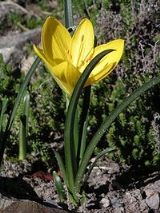
Sternbergia lutea
Encyclopedia
Sternbergia lutea is a bulbous
flowering plant
in the family Amaryllidaceae
, subfamily Amaryllidoideae, which is used as an ornamental plant
. It has yellow flowers which appear in autumn.
in the Western Mediterranean through to Tajikistan
in Central Asia. It dies down to a bulb during the summer. Leaves first appear in the autumn (September to November in its native habitats), and are glossy green, up to 12 mm wide; they remain through the winter. Deep yellow flowers with six yellow stamens appear soon after the leaves, with tepal
s around 3–3.5 mm long.
Smaller forms with narrower leaves (up to 5 mm wide) and narrower tepals (3–12 mm rather than 10–20 mm) have been separated off under various names (e.g. S. lutea var. graeca, S. sicula). All are treated as S. lutea in the Kew World Checklist.
7–9 (−18 to −1 °C) depending on the degree of protection given. It can be grown outside in the British Isles
in well-drained soil; a warm dry period in summer is required for good flowering. Alkaline soils are recommended. Bulbs are usually planted while dormant (i.e. in late summer or early autumn), but can be lifted and divided before the leaves die down in late spring.
A vigorous form with narrow leaves is grown in gardens under the name S. lutea var. angustifolia.
Bulb
A bulb is a short stem with fleshy leaves or leaf bases. The leaves often function as food storage organs during dormancy.A bulb's leaf bases, known as scales, generally do not support leaves, but contain food reserves to enable the plant to survive adverse conditions. At the center of the bulb is...
flowering plant
Flowering plant
The flowering plants , also known as Angiospermae or Magnoliophyta, are the most diverse group of land plants. Angiosperms are seed-producing plants like the gymnosperms and can be distinguished from the gymnosperms by a series of synapomorphies...
in the family Amaryllidaceae
Amaryllidaceae
Amaryllidoideae is the subfamily of flowering plants that takes its name from the genus Amaryllis. It is part of the family Amaryllidaceae, in order Asparagales...
, subfamily Amaryllidoideae, which is used as an ornamental plant
Ornamental plant
Ornamental plants are plants that are grown for decorative purposes in gardens and landscape design projects, as house plants, for cut flowers and specimen display...
. It has yellow flowers which appear in autumn.
Description
Sternbergia lutea has a wide distribution from the Balearic IslandsBalearic Islands
The Balearic Islands are an archipelago of Spain in the western Mediterranean Sea, near the eastern coast of the Iberian Peninsula.The four largest islands are: Majorca, Minorca, Ibiza and Formentera. The archipelago forms an autonomous community and a province of Spain with Palma as the capital...
in the Western Mediterranean through to Tajikistan
Tajikistan
Tajikistan , officially the Republic of Tajikistan , is a mountainous landlocked country in Central Asia. Afghanistan borders it to the south, Uzbekistan to the west, Kyrgyzstan to the north, and China to the east....
in Central Asia. It dies down to a bulb during the summer. Leaves first appear in the autumn (September to November in its native habitats), and are glossy green, up to 12 mm wide; they remain through the winter. Deep yellow flowers with six yellow stamens appear soon after the leaves, with tepal
Tepal
Tepals are elements of the perianth, or outer part of a flower, which include the petals or sepals. The term tepal is more often applied specifically when all segments of the perianth are of similar shape and color, or undifferentiated, which is called perigone...
s around 3–3.5 mm long.
Smaller forms with narrower leaves (up to 5 mm wide) and narrower tepals (3–12 mm rather than 10–20 mm) have been separated off under various names (e.g. S. lutea var. graeca, S. sicula). All are treated as S. lutea in the Kew World Checklist.
Cultivation
S. lutea is hardy to USDA hardiness zonesHardiness zone
A hardiness zone is a geographically defined area in which a specific category of plant life is capable of growing, as defined by climatic conditions, including its ability to withstand the minimum temperatures of the zone...
7–9 (−18 to −1 °C) depending on the degree of protection given. It can be grown outside in the British Isles
British Isles
The British Isles are a group of islands off the northwest coast of continental Europe that include the islands of Great Britain and Ireland and over six thousand smaller isles. There are two sovereign states located on the islands: the United Kingdom of Great Britain and Northern Ireland and...
in well-drained soil; a warm dry period in summer is required for good flowering. Alkaline soils are recommended. Bulbs are usually planted while dormant (i.e. in late summer or early autumn), but can be lifted and divided before the leaves die down in late spring.
A vigorous form with narrow leaves is grown in gardens under the name S. lutea var. angustifolia.

